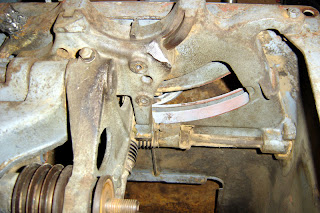Recently I've become interested in purchasing a bit heavier saw for the shop, preferably a decent Unisaw or Powermatic, to replace my aluminum Ryobi BT3000 (which I've used quite a bit since I originally bought it in 1993). I started watching Craigslist and one at a reasonable price came up - it was in Columbus GA and was listed as a 3HP Unisaw in working condition for $500 - this same saw was originally listed at $750 and I figured the guy was ready to make a deal. When I talked to him on the phone he indicated he would take $450 for it, so I took a trip down to Phenix City AL (right outside of Columbus, which is on the border of GA and AL). When I got there I was very dissappointed, as it wasn't the saw I thought I was getting - the 3HP units started becoming available in the 70's and are still made today - I thought that was what he had - instead I found an old 50's Unisaw with a 1HP motor.
I basically told him I didn't want it, but he asked me what I would offer him - I replied that I would pay $300 for the saw and he told me that it wasn't enough, etc. I started to drive off when he came back and offered to split the difference with me - I said no and he relented, so my trip wasn't wasted. I got a working saw for $300, and while it's not exactly what I wanted, I decided to start researching the saw and see what I needed to do to get it in fine woodworking condition. That's when I refound the Old Woodworking Machines forum. What I read there got me interested in fully restoring the saw. I had visited it previously to download a Dewalt catalog for my 790 Radial Arm Saw - which I found at an estate sale for $60. I started to restore the saw and have put if off for now, as the Unisaw is more interesting.
So here are images of the saw - only real issues: saw has been heavily painted, first red then gray, so it will require stripping to bare metal to make it right. The motor label is missing, one of the tables has a chunk busted out on the edge, and when I peeled off the top I found a welded front trunnion bracket. Here are the pics:








More images to follow as I start stripping down the saw for sand blasting.
-- John



































